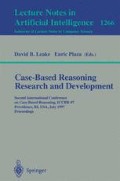Abstract
This paper presents a case-based tutor, CECELIA 1.1, that is based on techniques from CELIA, a computer model of case-based apprenticeship learning [Redmond 1992]. The teaching techniques include: interactive, step by step presentation of case solution steps, student predictions of an expert's actions, presentation of the expert's steps, student explanations of the expert's actions, and presentation of the expert's explanation. In addition, CECELIA takes advantage of a technique from VanLehn's [1987] SIERRA — presenting examples in an order so that solutions only differ by one branch, or disjunct, from previously presented examples. CECELIA relies on its teaching strategy encouraging greater processing of the examples by the student, rather than on embedding great amounts of intelligence in the tutor. CECELIA is implemented using HyperCard on an Apple Macintosh, and has been pilot tested with real students. The tests suggest that the approach can be helpful, but also suggest that eliciting self-explanations from students who normally do not self-explain may be challenging.
This research follows from work on CELIA which was supported by the Army Research Institute for the Behavioral and Social Sciences under Contract No. MDA-903-86-C-173, and Contract No. MDA-903-90-K-0112 and by DARPA contract F49620-88-C-0058 monitored by AFOSR. Work on CECELIA was partially supported by Rutgers University and Holy Family College. Thanks to Janet Kolodner for her advice and guidance concerning CELIA, and to Justin Peterson and Joel Martin for helpful discussion. Colleen Griffin did some of the development of the initial version of CECELIA.
Preview
Unable to display preview. Download preview PDF.
References
[Anderson et al., 1990] Anderson, J. R., Boyle, C. F., Corbett, A., & Lewis, M. W. (1990). Cognitive modeling and intelligent tutoring. Artificial Intelligence, 42:7–49.
Bareiss, R. (1989). Exemplar-based knowledge acquisition: a unified approach to concept representation, classification, and learning. Academic Press, New York, NY.
Carbonell, J. (1986). Derivational analogy: A theory of reconstructive problem solving and expertise acquisition. In Michalski, R., Carbonell, J., & Mitchell, T., editors, Machine Learning: An Artificial Intelligence Approach, Volume II. Morgan Kaufmann, Los Altos, CA.
Carbonell, J. & Veloso, M. (1988). Integrating derivational analogy into a general problem solving architecture. In Proceedings of a Workshop on Case-Based Reasoning, Clearwater, FL. Morgan Kaufmann.
[Chi et al., 1989] Chi, M., Bassok, M., Lewis, M., Reimann, P., & Glaser, R. (1989). Self-explanations: How students study and use examples to solve problems. Cognitive Science, 13:145–182.
[Chi et al., 1994] Chi, M., de Leeuw, N., Chiu, M., & LaVancher, C. (1994). Eliciting self-explanations improves understanding. Cognitive Science, 18:439–477.
Corbett, A. T. & Anderson, J. R. (1990). The effect of feedback control on learning to program with the lisp tutor. In Proceedings of the Twelfth Annual Conference of the Cognitive Science Society, pages 796–806, Cambridge, MA. Lawrence Erlbaum Associates.
Farr, M. J. & Psotka, J. (1992). Intelligent instruction by computer: Theory and practice. Taylor and Francis, New York, NY.
Koedinger, K. R. & Anderson, J. R. (1990). Abstract planning and perceptual chunks: elements of expertise in geometry. Cognitive Science, 14:511–550.
Kolodner, J. (1988). Retrieving events from a case memory: a parallel implementation. In Proceedings of a Workshop on Case-Based Reasoning, Clearwater, FL. Morgan Kaufmann.
Lancaster, J. & Kolodner, J. (1988). Varieties of learning from problem solving experience. In Proceedings of the Tenth Annual Conference of the Cognitive Science Society, Montreal, Canada. Lawrence Erlbaum Associates.
Nathan, M. J. & Resnick, L. B. (1995). Less can be more: Unintelligent tutoring based on psychological theories and experimentation. In Vosniadou, S., Corte, E. D., Glaser, R., & Mandl, H., editors, Psychological and Educational Foundations of Technology-Based Learning Environments.
Redmond, M. (1990). Distributed cases for case-based reasoning; facilitating use of multiple cases. In Proceedings of the National Conference on Artificial Intelligence (AAAI-90), Boston, MA. Morgan Kaufmann.
Redmond, M. (1992). Learning by Observing and Explaining Expert Problem Solving. PhD thesis, Georgia Institute of Technology, Atlanta, GA.
Redmond, M. (1994). Educational implications of celia: Learning by observing and explaining. In Proceedings of the Sixteenth Annual Conference of the Cognitive Science Society, Atlanta, GA. Lawrence Erlbaum Associates.
Renkl, A. (1996). Learning from worked out examples: A study of individual differences. Cognitive Science, 20.
Tarmizi, R. A. & Sweller, J. (1988). Guidance during mathematical problem solving. Journal of Educational Psychology, 80(4):424–436.
VanLehn, K. (1983). Felicity conditions for human skill acquisition: validating an ai-based theory. Technical Report CIS-21, Xerox Parc, Palo Alto, CA.
VanLehn, K. (1987). Learning one subprocedure per lesson. Artificial Intelligence, 31:1–40.
Wegner, E. (1987). Artificial intelligence and tutoring systems. Morgan Kaufmann, Los Altos, CA.
Winston, P. (1970). Learning Structural Descriptions from Examples. PhD thesis, Massachussetts Institute of Technology, Cambridge, MA.
Author information
Authors and Affiliations
Editor information
Rights and permissions
Copyright information
© 1997 Springer-Verlag Berlin Heidelberg
About this paper
Cite this paper
Redmond, M., Phillips, S. (1997). Encouraging self-explanation through case-based tutoring: A case study. In: Leake, D.B., Plaza, E. (eds) Case-Based Reasoning Research and Development. ICCBR 1997. Lecture Notes in Computer Science, vol 1266. Springer, Berlin, Heidelberg. https://doi.org/10.1007/3-540-63233-6_486
Download citation
DOI: https://doi.org/10.1007/3-540-63233-6_486
Published:
Publisher Name: Springer, Berlin, Heidelberg
Print ISBN: 978-3-540-63233-7
Online ISBN: 978-3-540-69238-6
eBook Packages: Springer Book Archive

